Operations, Logistics, and Supply Chain Management Analysis
VerifiedAdded on 2023/01/19
|10
|3240
|32
Report
AI Summary
This report provides an in-depth analysis of operations, logistics, and supply chain management, focusing on Aston Martin. It explores key areas such as new product development and quality management, examining the application of theories like Lean Production and Total Quality Management. The report highlights Aston Martin's current practices, identifying strengths and weaknesses in its processes, particularly in comparison to competitors like Lamborghini and BMW. It also examines specific issues related to product quality, such as reliability and safety concerns, and discusses the implications of these issues within the context of Total Quality Management principles. The report concludes by offering recommendations for improvement in areas such as new product development, quality control, and supply chain management to enhance overall performance.
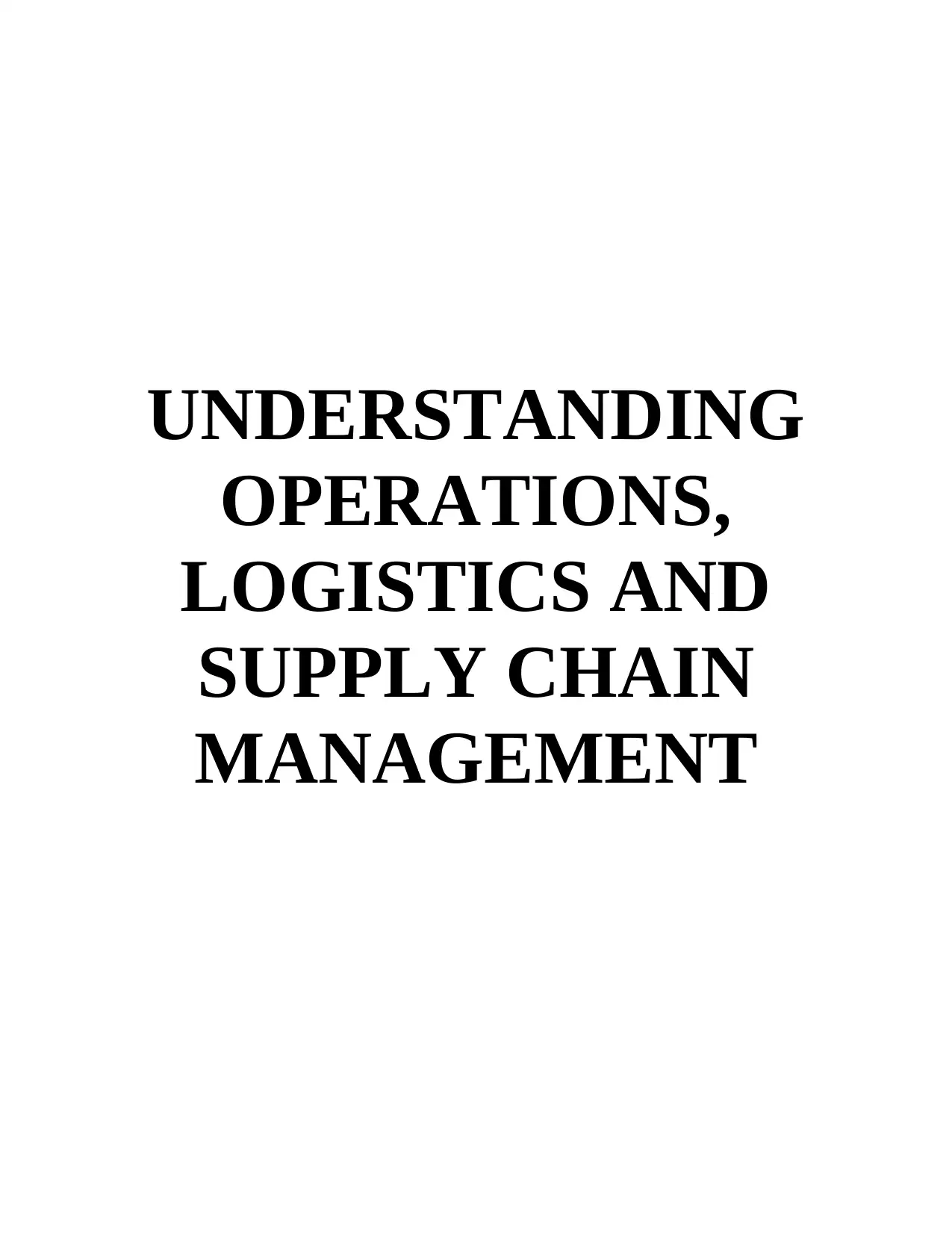
UNDERSTANDING
OPERATIONS,
LOGISTICS AND
SUPPLY CHAIN
MANAGEMENT
OPERATIONS,
LOGISTICS AND
SUPPLY CHAIN
MANAGEMENT
Paraphrase This Document
Need a fresh take? Get an instant paraphrase of this document with our AI Paraphraser

Table of Contents
INTRODUCTION...........................................................................................................................1
MAIN BODY...................................................................................................................................1
CONCLUSION................................................................................................................................6
REFERENCES................................................................................................................................8
INTRODUCTION...........................................................................................................................1
MAIN BODY...................................................................................................................................1
CONCLUSION................................................................................................................................6
REFERENCES................................................................................................................................8
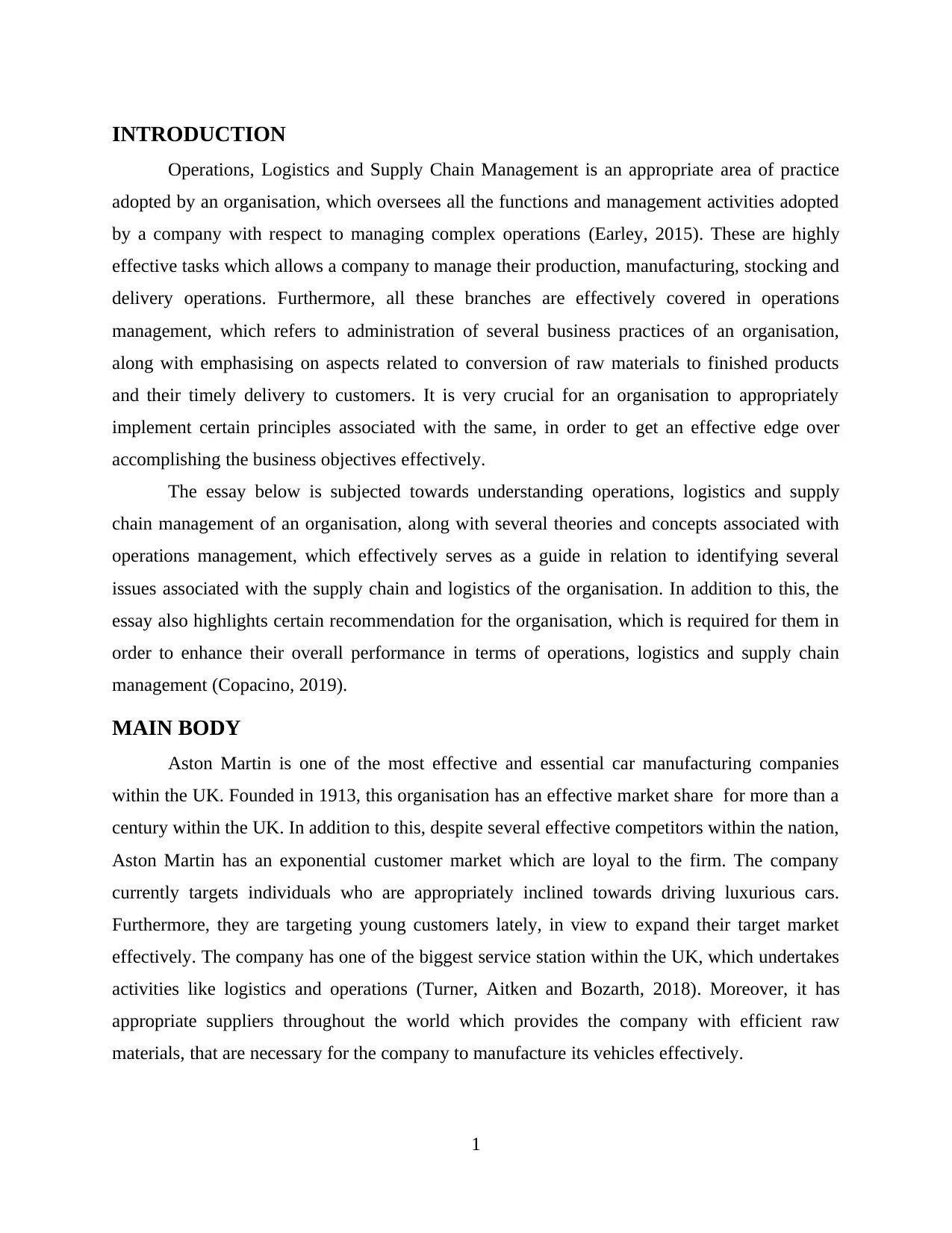
INTRODUCTION
Operations, Logistics and Supply Chain Management is an appropriate area of practice
adopted by an organisation, which oversees all the functions and management activities adopted
by a company with respect to managing complex operations (Earley, 2015). These are highly
effective tasks which allows a company to manage their production, manufacturing, stocking and
delivery operations. Furthermore, all these branches are effectively covered in operations
management, which refers to administration of several business practices of an organisation,
along with emphasising on aspects related to conversion of raw materials to finished products
and their timely delivery to customers. It is very crucial for an organisation to appropriately
implement certain principles associated with the same, in order to get an effective edge over
accomplishing the business objectives effectively.
The essay below is subjected towards understanding operations, logistics and supply
chain management of an organisation, along with several theories and concepts associated with
operations management, which effectively serves as a guide in relation to identifying several
issues associated with the supply chain and logistics of the organisation. In addition to this, the
essay also highlights certain recommendation for the organisation, which is required for them in
order to enhance their overall performance in terms of operations, logistics and supply chain
management (Copacino, 2019).
MAIN BODY
Aston Martin is one of the most effective and essential car manufacturing companies
within the UK. Founded in 1913, this organisation has an effective market share for more than a
century within the UK. In addition to this, despite several effective competitors within the nation,
Aston Martin has an exponential customer market which are loyal to the firm. The company
currently targets individuals who are appropriately inclined towards driving luxurious cars.
Furthermore, they are targeting young customers lately, in view to expand their target market
effectively. The company has one of the biggest service station within the UK, which undertakes
activities like logistics and operations (Turner, Aitken and Bozarth, 2018). Moreover, it has
appropriate suppliers throughout the world which provides the company with efficient raw
materials, that are necessary for the company to manufacture its vehicles effectively.
1
Operations, Logistics and Supply Chain Management is an appropriate area of practice
adopted by an organisation, which oversees all the functions and management activities adopted
by a company with respect to managing complex operations (Earley, 2015). These are highly
effective tasks which allows a company to manage their production, manufacturing, stocking and
delivery operations. Furthermore, all these branches are effectively covered in operations
management, which refers to administration of several business practices of an organisation,
along with emphasising on aspects related to conversion of raw materials to finished products
and their timely delivery to customers. It is very crucial for an organisation to appropriately
implement certain principles associated with the same, in order to get an effective edge over
accomplishing the business objectives effectively.
The essay below is subjected towards understanding operations, logistics and supply
chain management of an organisation, along with several theories and concepts associated with
operations management, which effectively serves as a guide in relation to identifying several
issues associated with the supply chain and logistics of the organisation. In addition to this, the
essay also highlights certain recommendation for the organisation, which is required for them in
order to enhance their overall performance in terms of operations, logistics and supply chain
management (Copacino, 2019).
MAIN BODY
Aston Martin is one of the most effective and essential car manufacturing companies
within the UK. Founded in 1913, this organisation has an effective market share for more than a
century within the UK. In addition to this, despite several effective competitors within the nation,
Aston Martin has an exponential customer market which are loyal to the firm. The company
currently targets individuals who are appropriately inclined towards driving luxurious cars.
Furthermore, they are targeting young customers lately, in view to expand their target market
effectively. The company has one of the biggest service station within the UK, which undertakes
activities like logistics and operations (Turner, Aitken and Bozarth, 2018). Moreover, it has
appropriate suppliers throughout the world which provides the company with efficient raw
materials, that are necessary for the company to manufacture its vehicles effectively.
1
⊘ This is a preview!⊘
Do you want full access?
Subscribe today to unlock all pages.

Trusted by 1+ million students worldwide
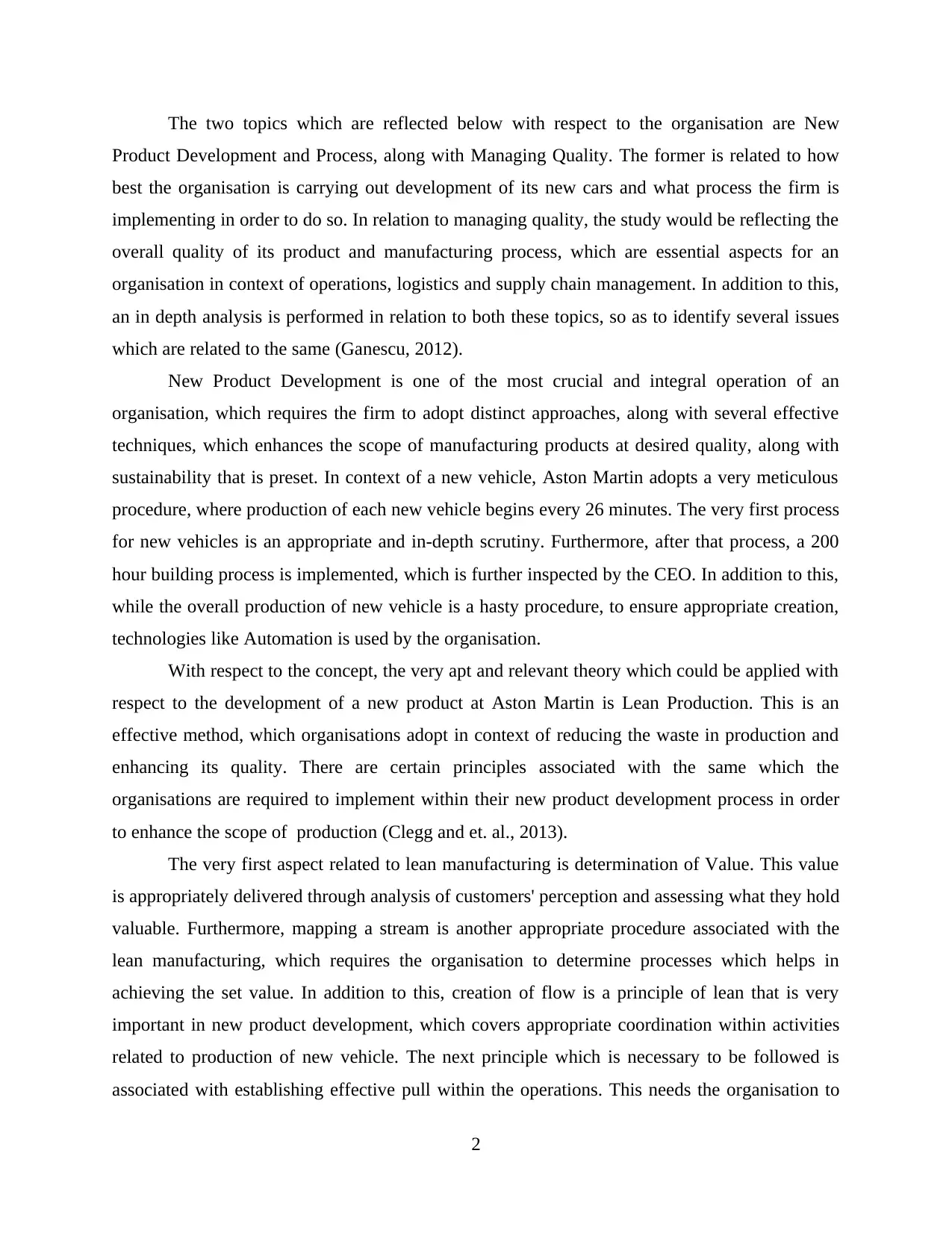
The two topics which are reflected below with respect to the organisation are New
Product Development and Process, along with Managing Quality. The former is related to how
best the organisation is carrying out development of its new cars and what process the firm is
implementing in order to do so. In relation to managing quality, the study would be reflecting the
overall quality of its product and manufacturing process, which are essential aspects for an
organisation in context of operations, logistics and supply chain management. In addition to this,
an in depth analysis is performed in relation to both these topics, so as to identify several issues
which are related to the same (Ganescu, 2012).
New Product Development is one of the most crucial and integral operation of an
organisation, which requires the firm to adopt distinct approaches, along with several effective
techniques, which enhances the scope of manufacturing products at desired quality, along with
sustainability that is preset. In context of a new vehicle, Aston Martin adopts a very meticulous
procedure, where production of each new vehicle begins every 26 minutes. The very first process
for new vehicles is an appropriate and in-depth scrutiny. Furthermore, after that process, a 200
hour building process is implemented, which is further inspected by the CEO. In addition to this,
while the overall production of new vehicle is a hasty procedure, to ensure appropriate creation,
technologies like Automation is used by the organisation.
With respect to the concept, the very apt and relevant theory which could be applied with
respect to the development of a new product at Aston Martin is Lean Production. This is an
effective method, which organisations adopt in context of reducing the waste in production and
enhancing its quality. There are certain principles associated with the same which the
organisations are required to implement within their new product development process in order
to enhance the scope of production (Clegg and et. al., 2013).
The very first aspect related to lean manufacturing is determination of Value. This value
is appropriately delivered through analysis of customers' perception and assessing what they hold
valuable. Furthermore, mapping a stream is another appropriate procedure associated with the
lean manufacturing, which requires the organisation to determine processes which helps in
achieving the set value. In addition to this, creation of flow is a principle of lean that is very
important in new product development, which covers appropriate coordination within activities
related to production of new vehicle. The next principle which is necessary to be followed is
associated with establishing effective pull within the operations. This needs the organisation to
2
Product Development and Process, along with Managing Quality. The former is related to how
best the organisation is carrying out development of its new cars and what process the firm is
implementing in order to do so. In relation to managing quality, the study would be reflecting the
overall quality of its product and manufacturing process, which are essential aspects for an
organisation in context of operations, logistics and supply chain management. In addition to this,
an in depth analysis is performed in relation to both these topics, so as to identify several issues
which are related to the same (Ganescu, 2012).
New Product Development is one of the most crucial and integral operation of an
organisation, which requires the firm to adopt distinct approaches, along with several effective
techniques, which enhances the scope of manufacturing products at desired quality, along with
sustainability that is preset. In context of a new vehicle, Aston Martin adopts a very meticulous
procedure, where production of each new vehicle begins every 26 minutes. The very first process
for new vehicles is an appropriate and in-depth scrutiny. Furthermore, after that process, a 200
hour building process is implemented, which is further inspected by the CEO. In addition to this,
while the overall production of new vehicle is a hasty procedure, to ensure appropriate creation,
technologies like Automation is used by the organisation.
With respect to the concept, the very apt and relevant theory which could be applied with
respect to the development of a new product at Aston Martin is Lean Production. This is an
effective method, which organisations adopt in context of reducing the waste in production and
enhancing its quality. There are certain principles associated with the same which the
organisations are required to implement within their new product development process in order
to enhance the scope of production (Clegg and et. al., 2013).
The very first aspect related to lean manufacturing is determination of Value. This value
is appropriately delivered through analysis of customers' perception and assessing what they hold
valuable. Furthermore, mapping a stream is another appropriate procedure associated with the
lean manufacturing, which requires the organisation to determine processes which helps in
achieving the set value. In addition to this, creation of flow is a principle of lean that is very
important in new product development, which covers appropriate coordination within activities
related to production of new vehicle. The next principle which is necessary to be followed is
associated with establishing effective pull within the operations. This needs the organisation to
2
Paraphrase This Document
Need a fresh take? Get an instant paraphrase of this document with our AI Paraphraser
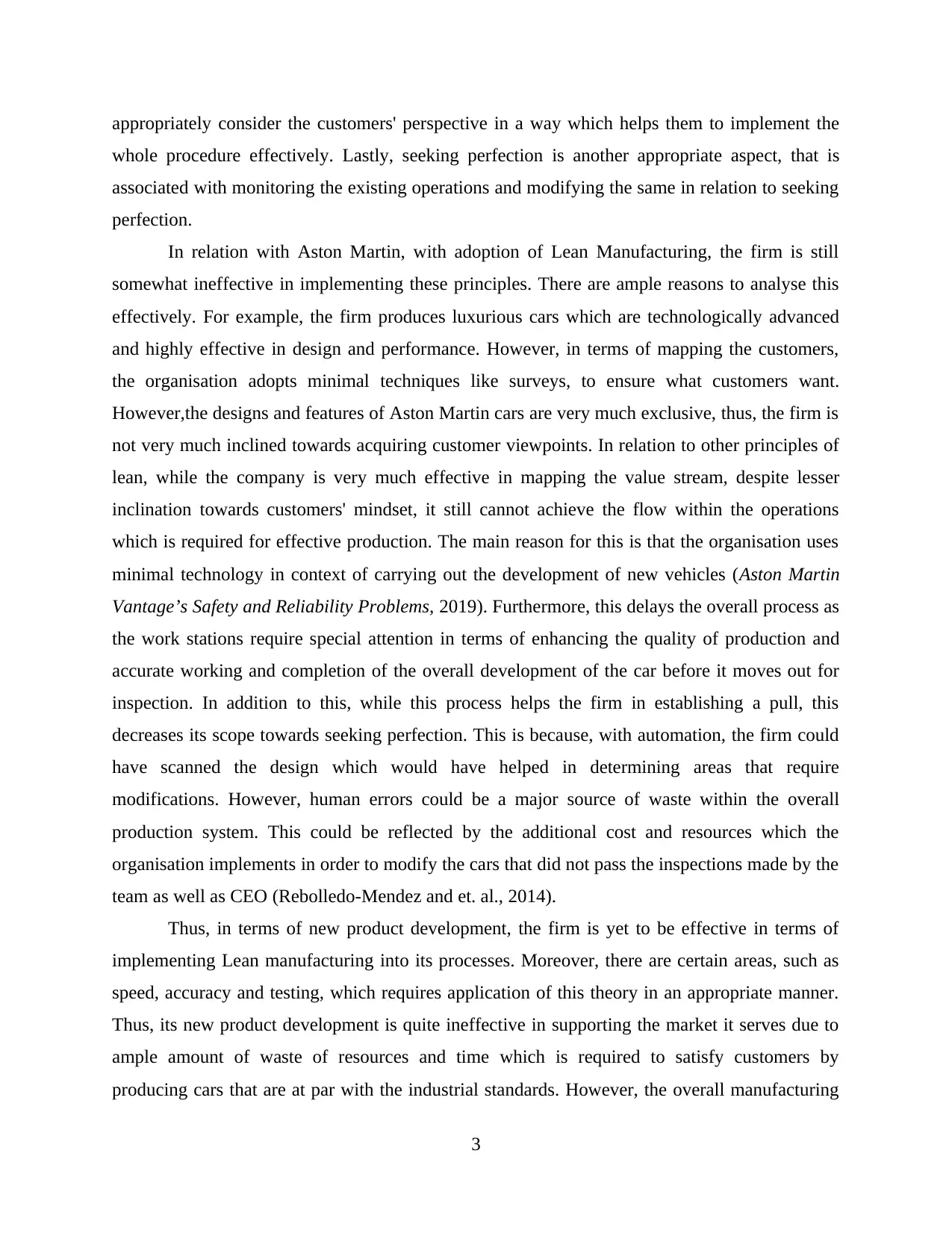
appropriately consider the customers' perspective in a way which helps them to implement the
whole procedure effectively. Lastly, seeking perfection is another appropriate aspect, that is
associated with monitoring the existing operations and modifying the same in relation to seeking
perfection.
In relation with Aston Martin, with adoption of Lean Manufacturing, the firm is still
somewhat ineffective in implementing these principles. There are ample reasons to analyse this
effectively. For example, the firm produces luxurious cars which are technologically advanced
and highly effective in design and performance. However, in terms of mapping the customers,
the organisation adopts minimal techniques like surveys, to ensure what customers want.
However,the designs and features of Aston Martin cars are very much exclusive, thus, the firm is
not very much inclined towards acquiring customer viewpoints. In relation to other principles of
lean, while the company is very much effective in mapping the value stream, despite lesser
inclination towards customers' mindset, it still cannot achieve the flow within the operations
which is required for effective production. The main reason for this is that the organisation uses
minimal technology in context of carrying out the development of new vehicles (Aston Martin
Vantage’s Safety and Reliability Problems, 2019). Furthermore, this delays the overall process as
the work stations require special attention in terms of enhancing the quality of production and
accurate working and completion of the overall development of the car before it moves out for
inspection. In addition to this, while this process helps the firm in establishing a pull, this
decreases its scope towards seeking perfection. This is because, with automation, the firm could
have scanned the design which would have helped in determining areas that require
modifications. However, human errors could be a major source of waste within the overall
production system. This could be reflected by the additional cost and resources which the
organisation implements in order to modify the cars that did not pass the inspections made by the
team as well as CEO (Rebolledo-Mendez and et. al., 2014).
Thus, in terms of new product development, the firm is yet to be effective in terms of
implementing Lean manufacturing into its processes. Moreover, there are certain areas, such as
speed, accuracy and testing, which requires application of this theory in an appropriate manner.
Thus, its new product development is quite ineffective in supporting the market it serves due to
ample amount of waste of resources and time which is required to satisfy customers by
producing cars that are at par with the industrial standards. However, the overall manufacturing
3
whole procedure effectively. Lastly, seeking perfection is another appropriate aspect, that is
associated with monitoring the existing operations and modifying the same in relation to seeking
perfection.
In relation with Aston Martin, with adoption of Lean Manufacturing, the firm is still
somewhat ineffective in implementing these principles. There are ample reasons to analyse this
effectively. For example, the firm produces luxurious cars which are technologically advanced
and highly effective in design and performance. However, in terms of mapping the customers,
the organisation adopts minimal techniques like surveys, to ensure what customers want.
However,the designs and features of Aston Martin cars are very much exclusive, thus, the firm is
not very much inclined towards acquiring customer viewpoints. In relation to other principles of
lean, while the company is very much effective in mapping the value stream, despite lesser
inclination towards customers' mindset, it still cannot achieve the flow within the operations
which is required for effective production. The main reason for this is that the organisation uses
minimal technology in context of carrying out the development of new vehicles (Aston Martin
Vantage’s Safety and Reliability Problems, 2019). Furthermore, this delays the overall process as
the work stations require special attention in terms of enhancing the quality of production and
accurate working and completion of the overall development of the car before it moves out for
inspection. In addition to this, while this process helps the firm in establishing a pull, this
decreases its scope towards seeking perfection. This is because, with automation, the firm could
have scanned the design which would have helped in determining areas that require
modifications. However, human errors could be a major source of waste within the overall
production system. This could be reflected by the additional cost and resources which the
organisation implements in order to modify the cars that did not pass the inspections made by the
team as well as CEO (Rebolledo-Mendez and et. al., 2014).
Thus, in terms of new product development, the firm is yet to be effective in terms of
implementing Lean manufacturing into its processes. Moreover, there are certain areas, such as
speed, accuracy and testing, which requires application of this theory in an appropriate manner.
Thus, its new product development is quite ineffective in supporting the market it serves due to
ample amount of waste of resources and time which is required to satisfy customers by
producing cars that are at par with the industrial standards. However, the overall manufacturing
3
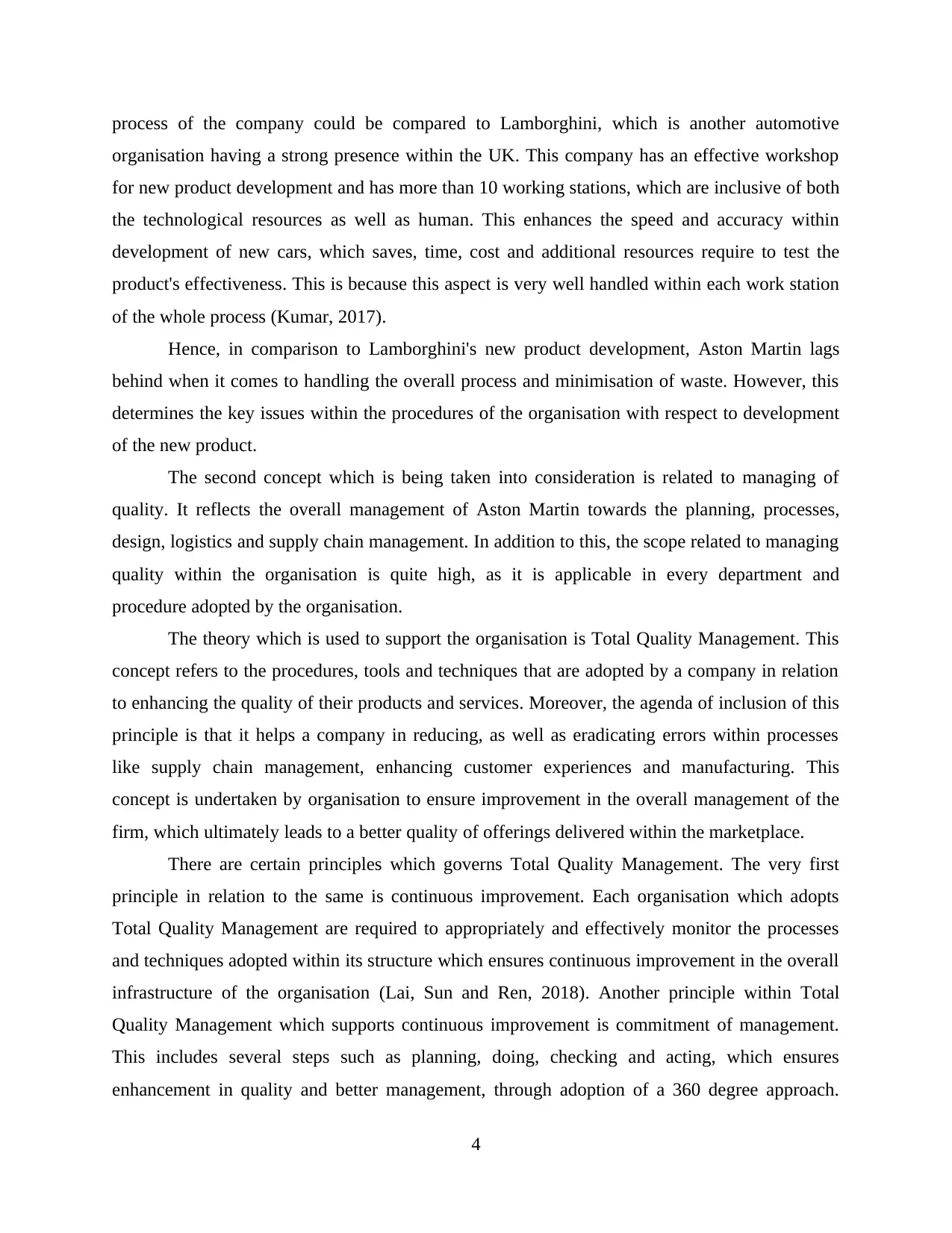
process of the company could be compared to Lamborghini, which is another automotive
organisation having a strong presence within the UK. This company has an effective workshop
for new product development and has more than 10 working stations, which are inclusive of both
the technological resources as well as human. This enhances the speed and accuracy within
development of new cars, which saves, time, cost and additional resources require to test the
product's effectiveness. This is because this aspect is very well handled within each work station
of the whole process (Kumar, 2017).
Hence, in comparison to Lamborghini's new product development, Aston Martin lags
behind when it comes to handling the overall process and minimisation of waste. However, this
determines the key issues within the procedures of the organisation with respect to development
of the new product.
The second concept which is being taken into consideration is related to managing of
quality. It reflects the overall management of Aston Martin towards the planning, processes,
design, logistics and supply chain management. In addition to this, the scope related to managing
quality within the organisation is quite high, as it is applicable in every department and
procedure adopted by the organisation.
The theory which is used to support the organisation is Total Quality Management. This
concept refers to the procedures, tools and techniques that are adopted by a company in relation
to enhancing the quality of their products and services. Moreover, the agenda of inclusion of this
principle is that it helps a company in reducing, as well as eradicating errors within processes
like supply chain management, enhancing customer experiences and manufacturing. This
concept is undertaken by organisation to ensure improvement in the overall management of the
firm, which ultimately leads to a better quality of offerings delivered within the marketplace.
There are certain principles which governs Total Quality Management. The very first
principle in relation to the same is continuous improvement. Each organisation which adopts
Total Quality Management are required to appropriately and effectively monitor the processes
and techniques adopted within its structure which ensures continuous improvement in the overall
infrastructure of the organisation (Lai, Sun and Ren, 2018). Another principle within Total
Quality Management which supports continuous improvement is commitment of management.
This includes several steps such as planning, doing, checking and acting, which ensures
enhancement in quality and better management, through adoption of a 360 degree approach.
4
organisation having a strong presence within the UK. This company has an effective workshop
for new product development and has more than 10 working stations, which are inclusive of both
the technological resources as well as human. This enhances the speed and accuracy within
development of new cars, which saves, time, cost and additional resources require to test the
product's effectiveness. This is because this aspect is very well handled within each work station
of the whole process (Kumar, 2017).
Hence, in comparison to Lamborghini's new product development, Aston Martin lags
behind when it comes to handling the overall process and minimisation of waste. However, this
determines the key issues within the procedures of the organisation with respect to development
of the new product.
The second concept which is being taken into consideration is related to managing of
quality. It reflects the overall management of Aston Martin towards the planning, processes,
design, logistics and supply chain management. In addition to this, the scope related to managing
quality within the organisation is quite high, as it is applicable in every department and
procedure adopted by the organisation.
The theory which is used to support the organisation is Total Quality Management. This
concept refers to the procedures, tools and techniques that are adopted by a company in relation
to enhancing the quality of their products and services. Moreover, the agenda of inclusion of this
principle is that it helps a company in reducing, as well as eradicating errors within processes
like supply chain management, enhancing customer experiences and manufacturing. This
concept is undertaken by organisation to ensure improvement in the overall management of the
firm, which ultimately leads to a better quality of offerings delivered within the marketplace.
There are certain principles which governs Total Quality Management. The very first
principle in relation to the same is continuous improvement. Each organisation which adopts
Total Quality Management are required to appropriately and effectively monitor the processes
and techniques adopted within its structure which ensures continuous improvement in the overall
infrastructure of the organisation (Lai, Sun and Ren, 2018). Another principle within Total
Quality Management which supports continuous improvement is commitment of management.
This includes several steps such as planning, doing, checking and acting, which ensures
enhancement in quality and better management, through adoption of a 360 degree approach.
4
⊘ This is a preview!⊘
Do you want full access?
Subscribe today to unlock all pages.

Trusted by 1+ million students worldwide
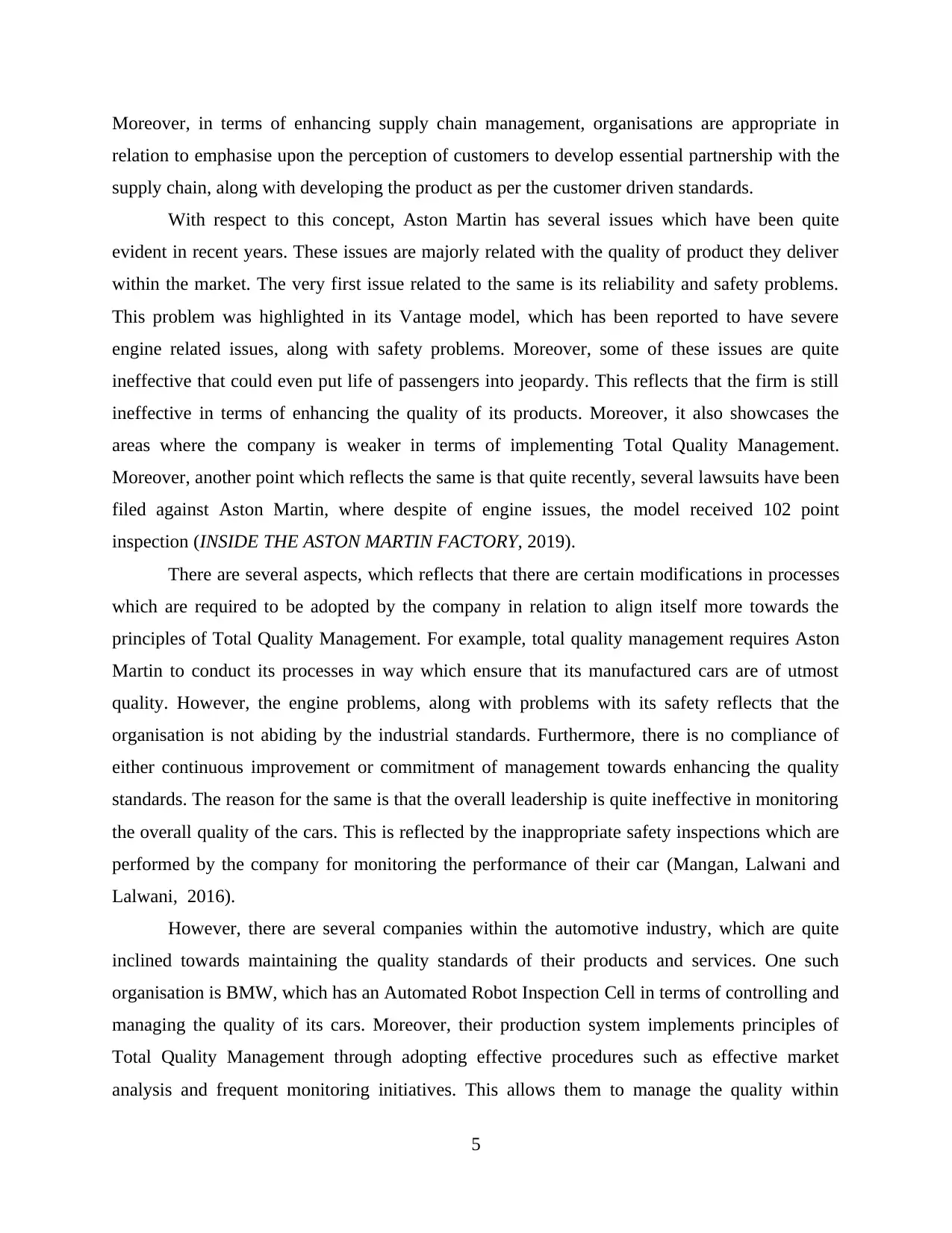
Moreover, in terms of enhancing supply chain management, organisations are appropriate in
relation to emphasise upon the perception of customers to develop essential partnership with the
supply chain, along with developing the product as per the customer driven standards.
With respect to this concept, Aston Martin has several issues which have been quite
evident in recent years. These issues are majorly related with the quality of product they deliver
within the market. The very first issue related to the same is its reliability and safety problems.
This problem was highlighted in its Vantage model, which has been reported to have severe
engine related issues, along with safety problems. Moreover, some of these issues are quite
ineffective that could even put life of passengers into jeopardy. This reflects that the firm is still
ineffective in terms of enhancing the quality of its products. Moreover, it also showcases the
areas where the company is weaker in terms of implementing Total Quality Management.
Moreover, another point which reflects the same is that quite recently, several lawsuits have been
filed against Aston Martin, where despite of engine issues, the model received 102 point
inspection (INSIDE THE ASTON MARTIN FACTORY, 2019).
There are several aspects, which reflects that there are certain modifications in processes
which are required to be adopted by the company in relation to align itself more towards the
principles of Total Quality Management. For example, total quality management requires Aston
Martin to conduct its processes in way which ensure that its manufactured cars are of utmost
quality. However, the engine problems, along with problems with its safety reflects that the
organisation is not abiding by the industrial standards. Furthermore, there is no compliance of
either continuous improvement or commitment of management towards enhancing the quality
standards. The reason for the same is that the overall leadership is quite ineffective in monitoring
the overall quality of the cars. This is reflected by the inappropriate safety inspections which are
performed by the company for monitoring the performance of their car (Mangan, Lalwani and
Lalwani, 2016).
However, there are several companies within the automotive industry, which are quite
inclined towards maintaining the quality standards of their products and services. One such
organisation is BMW, which has an Automated Robot Inspection Cell in terms of controlling and
managing the quality of its cars. Moreover, their production system implements principles of
Total Quality Management through adopting effective procedures such as effective market
analysis and frequent monitoring initiatives. This allows them to manage the quality within
5
relation to emphasise upon the perception of customers to develop essential partnership with the
supply chain, along with developing the product as per the customer driven standards.
With respect to this concept, Aston Martin has several issues which have been quite
evident in recent years. These issues are majorly related with the quality of product they deliver
within the market. The very first issue related to the same is its reliability and safety problems.
This problem was highlighted in its Vantage model, which has been reported to have severe
engine related issues, along with safety problems. Moreover, some of these issues are quite
ineffective that could even put life of passengers into jeopardy. This reflects that the firm is still
ineffective in terms of enhancing the quality of its products. Moreover, it also showcases the
areas where the company is weaker in terms of implementing Total Quality Management.
Moreover, another point which reflects the same is that quite recently, several lawsuits have been
filed against Aston Martin, where despite of engine issues, the model received 102 point
inspection (INSIDE THE ASTON MARTIN FACTORY, 2019).
There are several aspects, which reflects that there are certain modifications in processes
which are required to be adopted by the company in relation to align itself more towards the
principles of Total Quality Management. For example, total quality management requires Aston
Martin to conduct its processes in way which ensure that its manufactured cars are of utmost
quality. However, the engine problems, along with problems with its safety reflects that the
organisation is not abiding by the industrial standards. Furthermore, there is no compliance of
either continuous improvement or commitment of management towards enhancing the quality
standards. The reason for the same is that the overall leadership is quite ineffective in monitoring
the overall quality of the cars. This is reflected by the inappropriate safety inspections which are
performed by the company for monitoring the performance of their car (Mangan, Lalwani and
Lalwani, 2016).
However, there are several companies within the automotive industry, which are quite
inclined towards maintaining the quality standards of their products and services. One such
organisation is BMW, which has an Automated Robot Inspection Cell in terms of controlling and
managing the quality of its cars. Moreover, their production system implements principles of
Total Quality Management through adopting effective procedures such as effective market
analysis and frequent monitoring initiatives. This allows them to manage the quality within
5
Paraphrase This Document
Need a fresh take? Get an instant paraphrase of this document with our AI Paraphraser
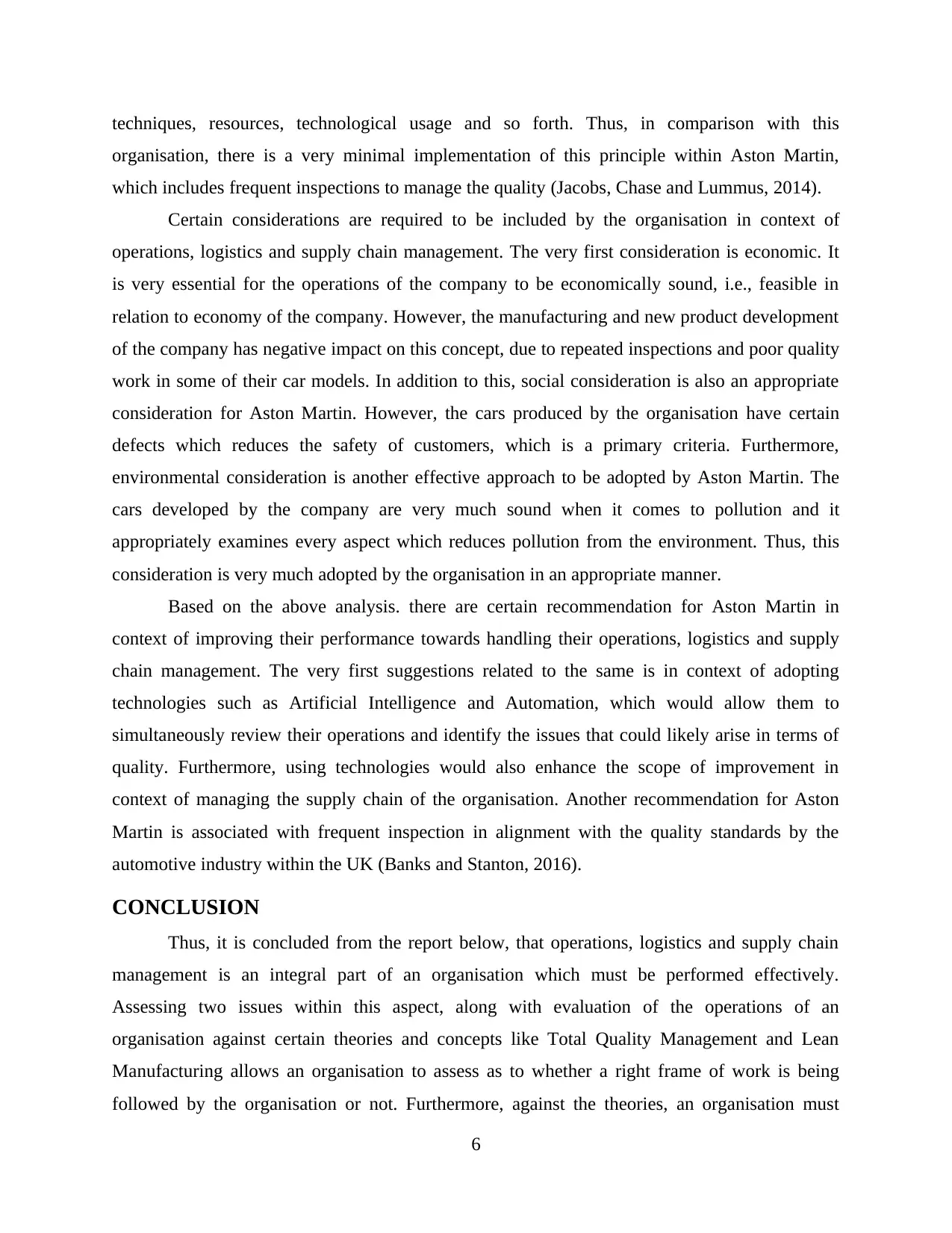
techniques, resources, technological usage and so forth. Thus, in comparison with this
organisation, there is a very minimal implementation of this principle within Aston Martin,
which includes frequent inspections to manage the quality (Jacobs, Chase and Lummus, 2014).
Certain considerations are required to be included by the organisation in context of
operations, logistics and supply chain management. The very first consideration is economic. It
is very essential for the operations of the company to be economically sound, i.e., feasible in
relation to economy of the company. However, the manufacturing and new product development
of the company has negative impact on this concept, due to repeated inspections and poor quality
work in some of their car models. In addition to this, social consideration is also an appropriate
consideration for Aston Martin. However, the cars produced by the organisation have certain
defects which reduces the safety of customers, which is a primary criteria. Furthermore,
environmental consideration is another effective approach to be adopted by Aston Martin. The
cars developed by the company are very much sound when it comes to pollution and it
appropriately examines every aspect which reduces pollution from the environment. Thus, this
consideration is very much adopted by the organisation in an appropriate manner.
Based on the above analysis. there are certain recommendation for Aston Martin in
context of improving their performance towards handling their operations, logistics and supply
chain management. The very first suggestions related to the same is in context of adopting
technologies such as Artificial Intelligence and Automation, which would allow them to
simultaneously review their operations and identify the issues that could likely arise in terms of
quality. Furthermore, using technologies would also enhance the scope of improvement in
context of managing the supply chain of the organisation. Another recommendation for Aston
Martin is associated with frequent inspection in alignment with the quality standards by the
automotive industry within the UK (Banks and Stanton, 2016).
CONCLUSION
Thus, it is concluded from the report below, that operations, logistics and supply chain
management is an integral part of an organisation which must be performed effectively.
Assessing two issues within this aspect, along with evaluation of the operations of an
organisation against certain theories and concepts like Total Quality Management and Lean
Manufacturing allows an organisation to assess as to whether a right frame of work is being
followed by the organisation or not. Furthermore, against the theories, an organisation must
6
organisation, there is a very minimal implementation of this principle within Aston Martin,
which includes frequent inspections to manage the quality (Jacobs, Chase and Lummus, 2014).
Certain considerations are required to be included by the organisation in context of
operations, logistics and supply chain management. The very first consideration is economic. It
is very essential for the operations of the company to be economically sound, i.e., feasible in
relation to economy of the company. However, the manufacturing and new product development
of the company has negative impact on this concept, due to repeated inspections and poor quality
work in some of their car models. In addition to this, social consideration is also an appropriate
consideration for Aston Martin. However, the cars produced by the organisation have certain
defects which reduces the safety of customers, which is a primary criteria. Furthermore,
environmental consideration is another effective approach to be adopted by Aston Martin. The
cars developed by the company are very much sound when it comes to pollution and it
appropriately examines every aspect which reduces pollution from the environment. Thus, this
consideration is very much adopted by the organisation in an appropriate manner.
Based on the above analysis. there are certain recommendation for Aston Martin in
context of improving their performance towards handling their operations, logistics and supply
chain management. The very first suggestions related to the same is in context of adopting
technologies such as Artificial Intelligence and Automation, which would allow them to
simultaneously review their operations and identify the issues that could likely arise in terms of
quality. Furthermore, using technologies would also enhance the scope of improvement in
context of managing the supply chain of the organisation. Another recommendation for Aston
Martin is associated with frequent inspection in alignment with the quality standards by the
automotive industry within the UK (Banks and Stanton, 2016).
CONCLUSION
Thus, it is concluded from the report below, that operations, logistics and supply chain
management is an integral part of an organisation which must be performed effectively.
Assessing two issues within this aspect, along with evaluation of the operations of an
organisation against certain theories and concepts like Total Quality Management and Lean
Manufacturing allows an organisation to assess as to whether a right frame of work is being
followed by the organisation or not. Furthermore, against the theories, an organisation must
6

evaluate how economic, environmental and social considerations are being inclusive within
operations of the company. Lastly, it is very essential that certain recommendations are provided
effectively in context with enhancing the scope of improvement within the firm.
7
operations of the company. Lastly, it is very essential that certain recommendations are provided
effectively in context with enhancing the scope of improvement within the firm.
7
⊘ This is a preview!⊘
Do you want full access?
Subscribe today to unlock all pages.

Trusted by 1+ million students worldwide
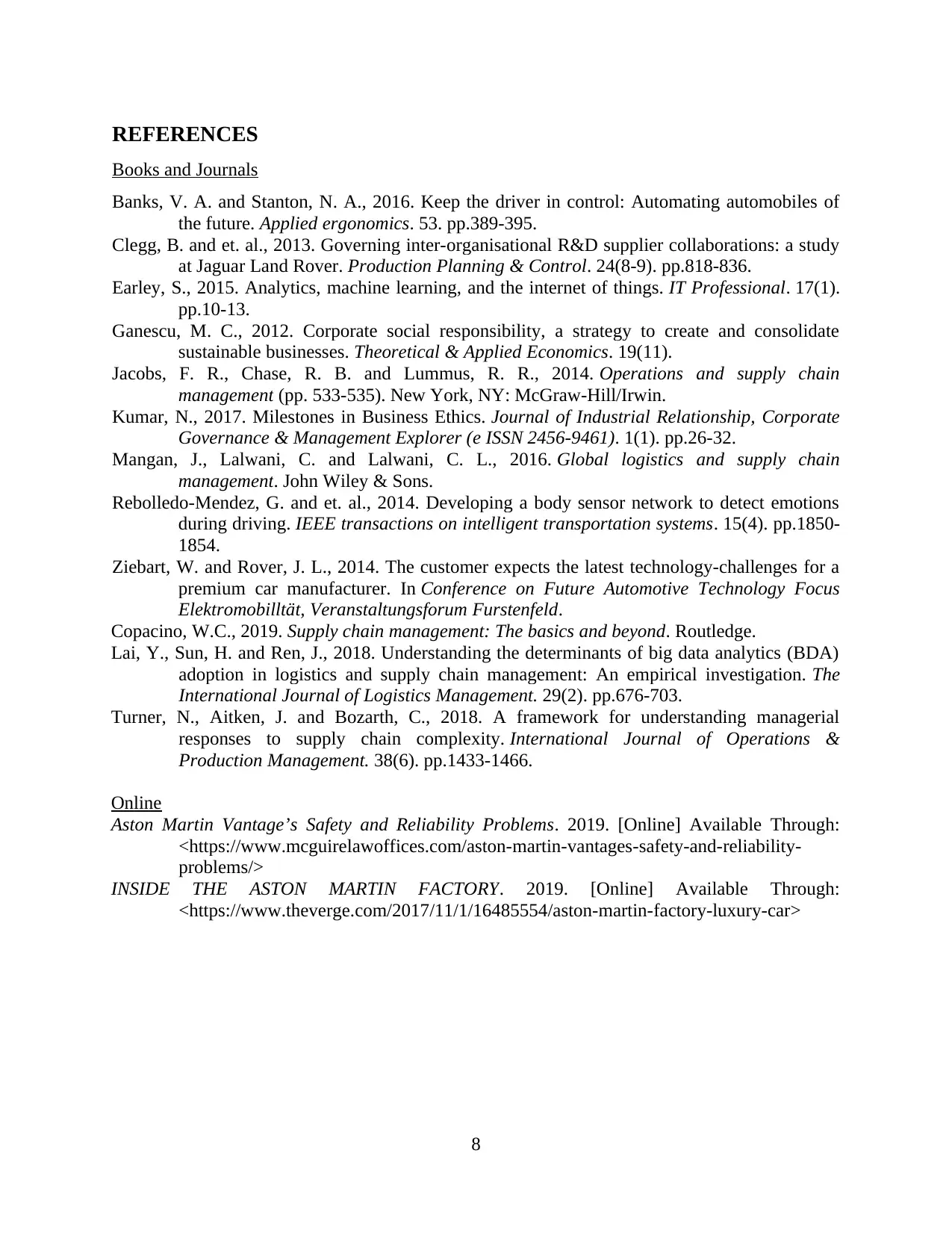
REFERENCES
Books and Journals
Banks, V. A. and Stanton, N. A., 2016. Keep the driver in control: Automating automobiles of
the future. Applied ergonomics. 53. pp.389-395.
Clegg, B. and et. al., 2013. Governing inter-organisational R&D supplier collaborations: a study
at Jaguar Land Rover. Production Planning & Control. 24(8-9). pp.818-836.
Earley, S., 2015. Analytics, machine learning, and the internet of things. IT Professional. 17(1).
pp.10-13.
Ganescu, M. C., 2012. Corporate social responsibility, a strategy to create and consolidate
sustainable businesses. Theoretical & Applied Economics. 19(11).
Jacobs, F. R., Chase, R. B. and Lummus, R. R., 2014. Operations and supply chain
management (pp. 533-535). New York, NY: McGraw-Hill/Irwin.
Kumar, N., 2017. Milestones in Business Ethics. Journal of Industrial Relationship, Corporate
Governance & Management Explorer (e ISSN 2456-9461). 1(1). pp.26-32.
Mangan, J., Lalwani, C. and Lalwani, C. L., 2016. Global logistics and supply chain
management. John Wiley & Sons.
Rebolledo-Mendez, G. and et. al., 2014. Developing a body sensor network to detect emotions
during driving. IEEE transactions on intelligent transportation systems. 15(4). pp.1850-
1854.
Ziebart, W. and Rover, J. L., 2014. The customer expects the latest technology-challenges for a
premium car manufacturer. In Conference on Future Automotive Technology Focus
Elektromobilltät, Veranstaltungsforum Furstenfeld.
Copacino, W.C., 2019. Supply chain management: The basics and beyond. Routledge.
Lai, Y., Sun, H. and Ren, J., 2018. Understanding the determinants of big data analytics (BDA)
adoption in logistics and supply chain management: An empirical investigation. The
International Journal of Logistics Management. 29(2). pp.676-703.
Turner, N., Aitken, J. and Bozarth, C., 2018. A framework for understanding managerial
responses to supply chain complexity. International Journal of Operations &
Production Management. 38(6). pp.1433-1466.
Online
Aston Martin Vantage’s Safety and Reliability Problems. 2019. [Online] Available Through:
<https://www.mcguirelawoffices.com/aston-martin-vantages-safety-and-reliability-
problems/>
INSIDE THE ASTON MARTIN FACTORY. 2019. [Online] Available Through:
<https://www.theverge.com/2017/11/1/16485554/aston-martin-factory-luxury-car>
8
Books and Journals
Banks, V. A. and Stanton, N. A., 2016. Keep the driver in control: Automating automobiles of
the future. Applied ergonomics. 53. pp.389-395.
Clegg, B. and et. al., 2013. Governing inter-organisational R&D supplier collaborations: a study
at Jaguar Land Rover. Production Planning & Control. 24(8-9). pp.818-836.
Earley, S., 2015. Analytics, machine learning, and the internet of things. IT Professional. 17(1).
pp.10-13.
Ganescu, M. C., 2012. Corporate social responsibility, a strategy to create and consolidate
sustainable businesses. Theoretical & Applied Economics. 19(11).
Jacobs, F. R., Chase, R. B. and Lummus, R. R., 2014. Operations and supply chain
management (pp. 533-535). New York, NY: McGraw-Hill/Irwin.
Kumar, N., 2017. Milestones in Business Ethics. Journal of Industrial Relationship, Corporate
Governance & Management Explorer (e ISSN 2456-9461). 1(1). pp.26-32.
Mangan, J., Lalwani, C. and Lalwani, C. L., 2016. Global logistics and supply chain
management. John Wiley & Sons.
Rebolledo-Mendez, G. and et. al., 2014. Developing a body sensor network to detect emotions
during driving. IEEE transactions on intelligent transportation systems. 15(4). pp.1850-
1854.
Ziebart, W. and Rover, J. L., 2014. The customer expects the latest technology-challenges for a
premium car manufacturer. In Conference on Future Automotive Technology Focus
Elektromobilltät, Veranstaltungsforum Furstenfeld.
Copacino, W.C., 2019. Supply chain management: The basics and beyond. Routledge.
Lai, Y., Sun, H. and Ren, J., 2018. Understanding the determinants of big data analytics (BDA)
adoption in logistics and supply chain management: An empirical investigation. The
International Journal of Logistics Management. 29(2). pp.676-703.
Turner, N., Aitken, J. and Bozarth, C., 2018. A framework for understanding managerial
responses to supply chain complexity. International Journal of Operations &
Production Management. 38(6). pp.1433-1466.
Online
Aston Martin Vantage’s Safety and Reliability Problems. 2019. [Online] Available Through:
<https://www.mcguirelawoffices.com/aston-martin-vantages-safety-and-reliability-
problems/>
INSIDE THE ASTON MARTIN FACTORY. 2019. [Online] Available Through:
<https://www.theverge.com/2017/11/1/16485554/aston-martin-factory-luxury-car>
8
1 out of 10
Related Documents
Your All-in-One AI-Powered Toolkit for Academic Success.
+13062052269
info@desklib.com
Available 24*7 on WhatsApp / Email
![[object Object]](/_next/static/media/star-bottom.7253800d.svg)
Unlock your academic potential
Copyright © 2020–2025 A2Z Services. All Rights Reserved. Developed and managed by ZUCOL.





